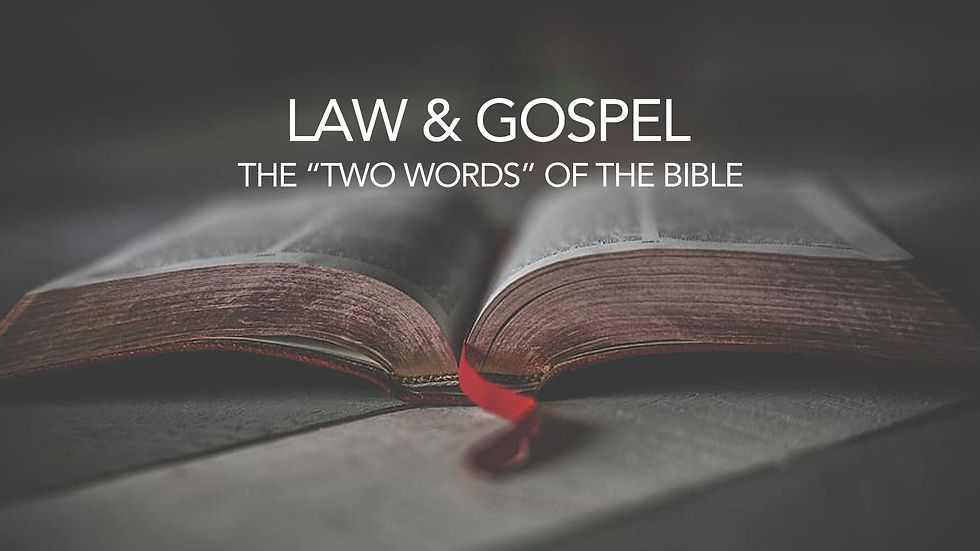He Is The Last Adam Because He Is The Lord From Heaven; The Second Man Because He Is The New Man Of The Resurrection And The Life
- Mark A. Smith
.JPG/v1/fill/w_320,h_320/file.jpg)
- Jan 22, 2024
- 3 min read
NICENE CREED

And in one Lord Jesus Christ
We now come to the second person of the one God who made the world and everything therein (Isa.42:1). The Nicene Creed approaches Him from a slightly different angle than the Apostles’ Creed. Both Creeds clearly recognize Jesus of Nazareth as the Christ and the second person of the one eternal Being of God co-existing with God as one God, but the Nicene Creed leads with Jesus of Nazareth as the Lord over all, who is also the Christ, whereas the Apostles’ Creed addresses Jesus Christ as “our Lord” from the perspective of the redeemed and saints only. Therefore, the Nicene Creed seeks to exalt Jesus Christ as Lord over more than that which is merely made subject to Him “willingly” in all things to the church (Rom.9:17-18). There is one Lord over all and above all, not just “our” one Lord to the church (Col.1:17-18). There is none higher nor more sovereign than the one Lord Jesus Christ in all of the heaven of the heavens or on all the earth (1 Cor.8:4-6).
That makes the Lordship of Jesus Christ particularly unique to what can only be known about God through the veil of the carnal nature and the fleshly ordinances that symbolize the death of his humanity (2 Cor.5:16; 1 Cor.8:7; Rom.14:7-9; 2Cor.4:3-7). There is only one Lord and the same Christ to both represent God from heaven and the sinful man of the fallen race, creating peace by making one new and incorruptible man as the “Lord” from heaven from the two races, one of heaven and the other of earth (Eph.2:14-18; Rom.8:3-4; 1 Cor.15:21-24, 45, 50), reconciling the world to God (in Christ the Lord) (2 Cor.5:17-21). Therefore, as the one Lord from heaven (Lam.3:50; 1 Cor.15:47), he was given the name above all names (Phil.2:8-11), which no name under heaven can match (Phil.3:20; 2 Thess.1:7; Acts 4:10-12), by which every knee shall bow in heaven and on earth and below the earth as the Lord of glory and Lord over them all (Rom.10:8-13; Acts 10:35-38; Ps.72:9; Pr.14:19).
Therefore as the incorruptible image of God (Rom.1:23; 1 Cor.15:42, 50; Col.1:15; Heb.1:3; Acts 2:27), the Lord Jesus Christ is the Lord of lords and God of gods (Jn.10:34-38; Dt.10:17; Jos.22:22; Dan.11:36; 2 Thess.2:4; 1 Tim.6:15; Rev.17:14), for whom the Lord came and preached the incorruptible Word of God as that incorruptible seed of regeneration to those corrupted by the corruptible image of Adam’s offense against the likeness of the living God (Rom.5:14; 1 Pet.1:3-5, 23-25; Jn.1:1-2, 14). Therefore, as the Lord from heaven, Jesus Christ is the last Adam (1 Cor.15:45), for all who came before His representation of the image of God were thieves and robbers of those things eternal to the economy of the tree of life (Jn.10:6-9; Gen.3:24; Matt.16:18; Lk.11:52), but Christ came as the open door to the gift of God’s grace according to the promise and Word of life for those who would believe through His mediation and surety (Jn.3:16; 10:11, 14-18). Therefore, as Lord, Jesus is the door into the pasture and paradise of the Tree of Life.
“Though it seems to have loomed larger at Rome than elsewhere, this solemn rehearsal, or reddition, of the creed before baptism was universally observed in the West. It was treated as the occasion for a special sermon, and a number of such discourses have come down to us. St Augustine testifies to the importance it assumed in Africa. Not that he suggests that it was the only, or even the most prominent, affirmation of faith at baptism. The declaratory recital of the creed, as his references to it make plain, was the concluding stage in the catechumenate, whereas the confession at the moment of baptism was in the form of answers to interrogations.”1
1 J. N. D. Kelly, Early Christian Creeds, Third Edition. (London; New York: Continuum, 2006), 36.























Comments